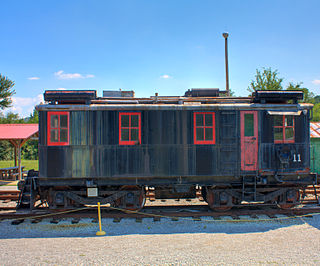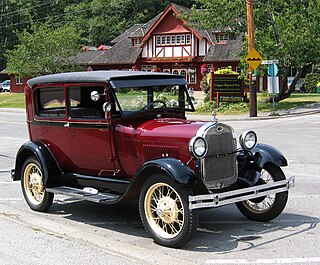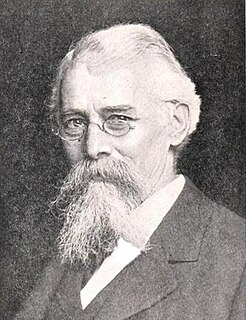
An assembly line is a manufacturing process in which parts are added as the semi-finished assembly moves from workstation to workstation where the parts are added in sequence until the final assembly is produced. By mechanically moving the parts to the assembly work and moving the semi-finished assembly from work station to work station, a finished product can be assembled faster and with less labor than by having workers carry parts to a stationary piece for assembly.

A museum is a building or institution that cares for and displays a collection of artifacts and other objects of artistic, cultural, historical, or scientific importance. Many public museums make these items available for public viewing through exhibits that may be permanent or temporary. The largest museums are located in major cities throughout the world, while thousands of local museums exist in smaller cities, towns, and rural areas. Museums have varying aims, ranging from the conservation and documentation of their collection, serving researchers and specialists, to catering to the general public. The goal of serving researchers is not only scientific, but intended to serve the general public.

Mass production, also known as flow production or continuous production, is the production of substantial amounts of standardized products in a constant flow, including and especially on assembly lines. Together with job production and batch production, it is one of the three main production methods.

The Ford Model T is an automobile that was produced by Ford Motor Company from October 1, 1908, to May 26, 1927. It is generally regarded as the first affordable automobile, which made car travel available to middle-class Americans. The relatively low price was partly the result of Ford's efficient fabrication, including assembly line production instead of individual handcrafting. It was mainly designed by an American and two Hungarian engineers. The Model T was colloquially known as the "Tin Lizzie", "Leaping Lena" or "flivver".

A carriage is a private four-wheeled vehicle for people and is most commonly horse-drawn. Second-hand private carriages were common public transport, the equivalent of modern cars used as taxis. Carriage suspensions are by leather strapping and, on those made in recent centuries, steel springs. Two-wheeled carriages are informal and usually owner-driven.
Post-Fordism is the dominant system of economic production, consumption, and associated socio-economic phenomena in most industrialized countries since the late 20th century. It is contrasted with Fordism, the system formulated in Henry Ford's automotive factories, in which workers work on a production line, performing specialized tasks repetitively, and organized through Taylorist scientific management. Definitions of the nature and scope of post-Fordism vary considerably and are a matter of debate among scholars. Changes in the nature of the workforce include the growth of labor processes and workflows relying on information and communication technologies and digital labor.

Four-wheel drive, also called 4×4 or 4WD, refers to a two-axled vehicle drivetrain capable of providing torque to all of its wheels simultaneously. It may be full-time or on-demand, and is typically linked via a transfer case providing an additional output drive shaft and, in many instances, additional gear ranges.

The Fashion Institute of Technology (FIT) is a public college in New York City. It is part of the State University of New York (SUNY) and focuses on art, business, design, mass communication, and technology connected to the fashion industry. It was founded in 1944.

In an internal combustion engine, the engine block is the structure which contains the cylinders and other components. In an early automotive engine, the engine block consisted of just the cylinder block, to which a separate crankcase was attached. Modern engine blocks typically have the crankcase integrated with the cylinder block as a single component. Engine blocks often also include elements such as coolant passages oil galleries.

Barbara Nessim is an American artist, illustrator, and educator.

The ALCO boxcabs were diesel-electric switcher locomotives, otherwise known as AGEIR boxcabs as a contraction of the names of the builders. Produced by a partnership of three companies, ALCO built the chassis and running gear, General Electric the generator, motors and controls, and Ingersoll Rand the diesel engine. The principle of operation was the same as modern locomotives, the diesel engine driving a main generator of 600 volts DC with four traction motors, one per axle.

A centreless wheel is a wheel that lacks a centre or hub, instead being supported and driven at the rim.

The Ford Model A was the Ford Motor Company's second market success, replacing the venerable Model T which had been produced for 18 years. It was first produced on October 20, 1927, but not introduced until December 2. This new Model A was designated a 1928 model and was available in four standard colors. The vehicle was also sold in Europe, but was replaced by locally built cars such as the Ford Model Y.

The Knoxville Museum of Art (KMA), is an art museum in Knoxville, Tennessee. It specializes in historical and contemporary art pieces from the East Tennessee region. According to its mission statement, the museum "celebrates the art and artists of East Tennessee, presents new art and new ideas, educates and serves a diverse community, enhances Knoxville’s quality of life, and operates ethically, responsibly, and transparently as a public trust."
Carrie Mae Weems is an American artist working in text, fabric, audio, digital images and installation video, and is best known for her photography. She achieved prominence through her early 1990s photographic project The Kitchen Table Series. Her photographs, films and videos focus on serious issues facing African Americans today, including racism, sexism, politics and personal identity.

A fingerboard is a scaled-down replica of a skateboard that a person "rides" with their fingers, rather than their feet. A fingerboard is typically 100 millimeters (3.9 in) long with width ranging from 26 to 55 mm, with graphics, trucks and plastic or ball-bearing wheels, like a skateboard. A fingerboard can be used to do traditional skateboard tricks, such as an ollie, kickflip, and more.

The Mason Machine Works was a machinery manufacturing company located in Taunton, Massachusetts, between 1845 and 1944. The company became famous for an early invention by its creator, William Mason, the self-acting mule, first patented in 1840. The company also later produced locomotives, rifles during the American Civil War, and later printing presses. However, the production of textile machinery would remain the company's core business during the late 19th century, until its decline in the 1920s.

Bombardier Zefiro is a family of high-speed passenger trains designed by Bombardier Transportation whose variants have top operating speeds of between 250 km/h (160 mph) ; 380 km/h (240 mph) and 400 km/h (250 mph).

A brakeboard is a skateboard fitted with a specialised truck assembly that includes a braking mechanism.

Thomas Hall was a nineteenth century American engineer, mechanic, and inventor. In the field of mechanical engineering he first turned to inventing improved and specialized sewing machines. This led him to inventing enhanced typewriters, especially portable ones. Although he built prototypes in the 1860s, it was not until 1881 that he was ready to manufacture the Hall Typewriter, put it on the market, and sell to the public. This was the first portable typewriter and the world's first "laptop" since the machine could be used on one's lap. These portable typewriters were manufactured for twenty years in New York City, Boston, and Salem, Massachusetts. The printing mechanism was built into a wooden carrying case and the compact light-weight portable typewriter that Hall manufactured sold for half the price of a standard typewriter. Hall was a patent attorney in the later part of his life.